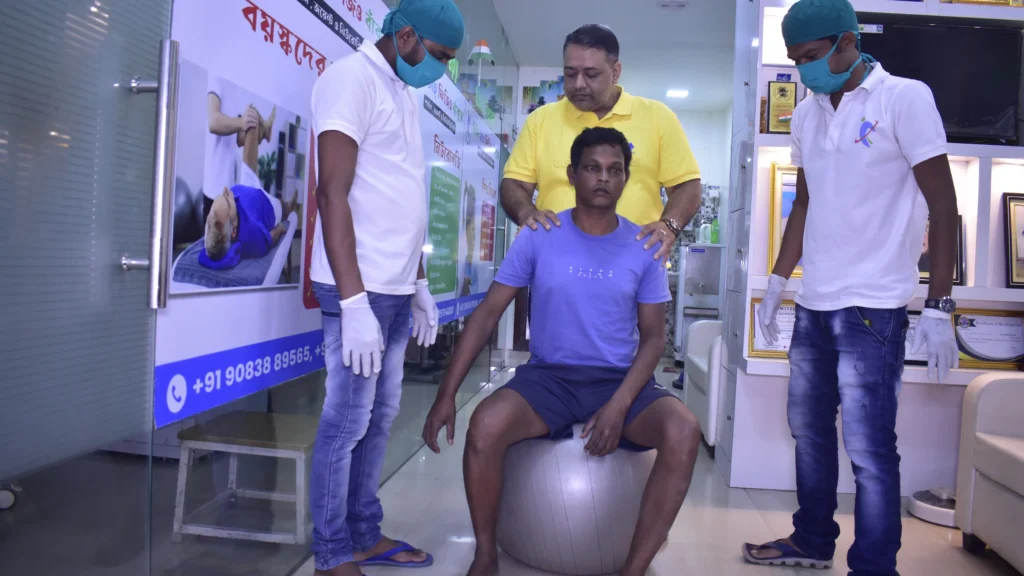- Request a Callback
Home > Paralysis Treatment
Stroke paralysis refers to the loss of muscle function in part of the body due to damage in the brain caused by a stroke. A stroke occurs when the blood supply to a part of the brain is interrupted or reduced, depriving brain tissue of oxygen and nutrients. This leads to brain cells dying within minutes.
Healing from stroke paralysis using Healing Touch’s advanced physiotherapy involves a combination of modern techniques, technology, and personalized rehab plans that target neuroplasticity — the brain’s ability to rewire itself and form new connections. While full recovery can vary, many patients make significant improvements with the right approach.
The unaffected limb is restrained to encourage use of the paralyzed one. It forces the brain to relearn control of the weaker limb, promoting neuroplasticity.
Low-level electrical currents stimulate paralyzed muscles. Helps retrain muscles to move and improves coordination by mimicking natural nerve signals.
Devices like exoskeletons or robotic arms/legs help guide movement. Supports repetitive motion training with precision, which is key for brain rewiring.
Immersive environments guide the patient through exercises and tasks. It’s engaging and allows safe practice of real-world scenarios, helping the brain adapt.
A mirror is used to reflect the moving limb, tricking the brain into thinking the paralyzed limb is moving. Activates motor areas of the brain and encourages movement.
Focuses on real-life activities (e.g., grasping a cup, walking).
Encourages repetitive practice of meaningful movements.
Patients relearn walking with reduced pressure on legs.
Often combined with robotics or VR.
Activities designed to challenge the brain and stimulate motor control areas.
Includes repetition, variation, and problem-solving tasks.



Matrix Rhythm Therapy (MaRhyThe®) is a relatively newer approach in stroke rehabilitation, and it’s gaining attention for its potential benefits in managing stroke-induced paralysis and spasticity. Matrix Rhythm Therapy is a vibration-based therapy developed in Germany which uses a device that mimics the natural micro-vibrations of healthy skeletal muscle. These vibrations aim to stimulate cellular activity, improve circulation, and restore rhythmic movement at the neuromuscular and cellular level.
Matrix Rhythm Therapy aims to:
Magneto Therapy — also known as Pulsed Electromagnetic Field Therapy (PEMF) — is another supportive treatment gaining traction in stroke rehabilitation, especially for stroke-induced paralysis, spasticity, and pain management. Magneto Therapy uses low-frequency electromagnetic fields to stimulate tissues. The fields penetrate deep into the body and are believed to:
FDM Therapy (Fascial Distortion Model Therapy) is a manual therapy technique that’s gaining attention in the world of neurological and stroke rehabilitation, especially for addressing pain, restricted movement, and functional limitations caused by post-stroke paralysis.
Let’s dive into how FDM works in this context and why some therapists are integrating it into stroke rehab plans:
Improving Fascial Mobility: After a stroke, especially with paralysis or spasticity, the fascia can become tight, restricted, or adhesed. FDM techniques help break down these restrictions, improving range of motion.
Reducing Spasticity and Muscle Tightness: Fascia plays a role in how muscles respond to neural input. When fascia is freed, muscle tone may normalize, helping with rigid or spastic limbs.
Pain Relief: Many stroke survivors develop shoulder pain, contractures, or postural strain. FDM helps target pain points caused by fascial strain.
Enhancing Proprioception and Motor Control: Freeing up fascial pathways may enhance sensory feedback, which is crucial for regaining voluntary control in paralyzed limbs.
The importance of timely treatment in stroke rehabilitation cannot be overstated — it is absolutely critical to the patient’s long-term outcome. The earlier rehabilitation starts, the better the chances of recovery, especially in terms of regaining motor function, speech, and independence.
**Patients in the Golden Period have the highest chances of full recovery. The first 90 days post-paralysis is considered to be the golden period. Starting rehab early takes advantage of this window to retrain the brain and restore lost functions.

At Healing Touch, Bankura, physiotherapy plays a vital role in the rehabilitation of stroke paralysis. The goal is to improve motor function, restore independence, and enhance the quality of life. Physiotherapists design personalized treatment plans based on each patient’s specific needs and recovery potential.
Healing Touch Bankura stands as a beacon of hope and recovery for patients in need of expert physiotherapy and stroke rehabilitation. Established by the visionary duo, Dr. Somsubhra Mondal and Dr. Pooja Thakur, the clinic has carved a niche for itself in providing comprehensive, patient-centric care. The clinic specializes in treating a wide range of physical conditions, including post-stroke rehabilitation, musculoskeletal disorders, neurological issues, and sports injuries. The emphasis is on restoring mobility, alleviating pain, and enhancing the quality of life through customized treatment plans.With a state-of-the-art facility equipped with advanced equipment, Healing Touch Bankura offers specialized services that are tailored to meet the unique needs of each patient.

Healing touch physio Bankura is one of the most Effective pain & Advanced Neuro Clinic in India. We provide the best technology for ( US FDA-approved machines and the most advanced research-based technology) for Treatment for faster recovery & healing with a non-surgical approach.